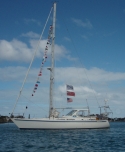A boat , who has not sailed to NZ before, asked whether it would be useful to stop at either Minerva Reef or Norfolk Island. Hmmm. Here is David's response. Note that there are two papers in the Gulf Harbour Radio Library worth a read on this topic. "Sailing to NZ" and " Tonga to NZ". (Www.ghradio.co.nz and click on WEATHER).
1. Minerva. A great place to stop to break up a voyage particularly if you depart from Tonga. Also a great place to visit if you've never been there. It's best to visit Minerva when you head NORTH from NZ. Sailing there from Fiji is tough due to the winds being mainly SE quadrant and it becomes a tough beat or many many tacks. If all you want to do is to sail to NZ then wait to visit next year.
2. Norfolk. A lovely place to visit via 737. On a yacht be aware that the anchorages are generally rolly and often you must shift locations as the wind changes. Also it is very difficult to land and often dangerous. Also one person must remain on the yacht capable of moving it if required. There is absolutely no tactical advantage to go there as the trip to NZ is a bit tricky and why make a passage longer than necessary. Also customs/immigration rules have changed, thus previous notice must be given and granted.
On the Www.ghradio.co.nz library there are a few articles on sailing to NZ; check these out. The most important thing for you to do in your passage planning to NZ is to understand what the weather will be on arrival. This is far more important that departure weather. You need to establish if the weather forecast for your ETA is weather you want or can deal with. We have not counted how many times we have had to coordinate and communicate with RCC (NZ Rescue and coordination center) data on yachts that have ignored this step. 50 knot SW winds are not a nice arrival experience.
The Fiji trip generally involves using a waypoint just NNW of North Cape. See the GHRadio library. This assumes encountering a frontal band around 30S then rhumb line the rest of the voyage on the wind shift. However this is not always the case; often a rhumb line from Fiji works with no fronts at all. In fact this current window may be such a case. Sometimes easting is required. All this depends on the shape of the isobars and whether you are sailing into a depression or anticyclone. I repeat, determine your destination weather before you leave. Also make a passage plan with a minimum predetermined speed. If you need to start the engine, do so; you do not sit and bob around in calms.
I hope this addresses your questions. Make a point of checking in with Maritime Radio every day. This can be at any time but we have found propagation is best around dinner time. Their office is next door to RCC; any problems can be addressed instantly. Plus they are a friendly bunch. Naturally you can talk to us every morning on the GHR sked.
